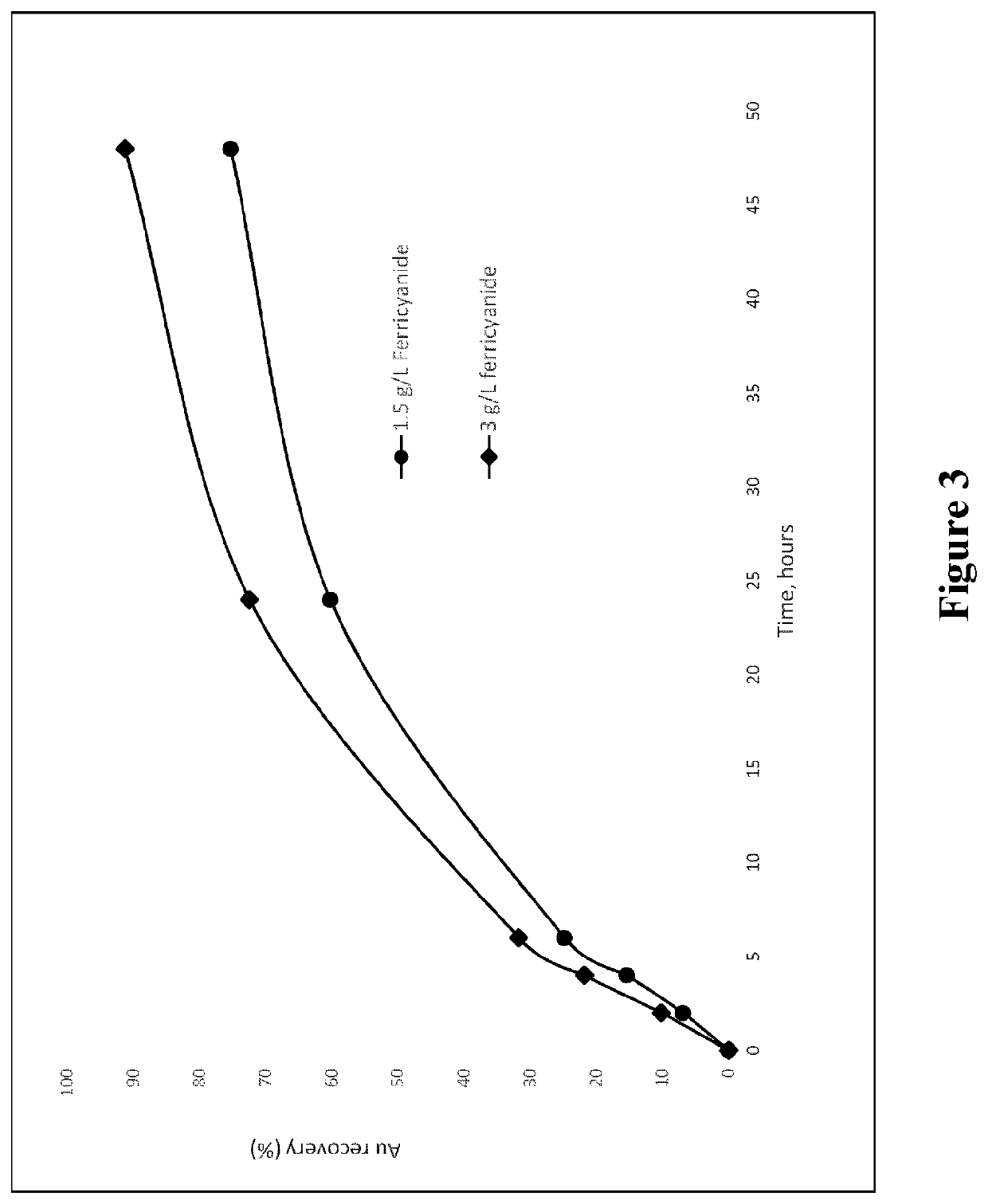Recovery of precious and chalcophile metals
a precious and chalcophile metal technology, applied in the field of precious and chalcophile metal recovery, can solve the problems of increasing operating expenses, increasing operating costs, and increasing the introduction of impurities with attendant downstream processing complications, and avoiding copper contamination in downstream recovery. , the effect of limiting the contamination of downstream processing
- Summary
- Abstract
- Description
- Claims
- Application Information
AI Technical Summary
Benefits of technology
Problems solved by technology
Method used
Image
Examples
example 1
[0070]A gold ore was leached in an aqueous pulp containing 33.3% solids at room temperature (20 degrees Celsius) at a pH of 11. Leaching was conducted in three solutions containing: (a) glycine only, (b) Fe complex only and (c) glycine and Fe complex. The following was noted during bottle roll tests:[0071](a) For the case of using glycine only (using 7.5 g / L), in the absence of any alkali-stable transition metal complex, the gold extraction into solution is only about 1% after 48 hours leaching.[0072](b) For the case of the alkali-stable transition metal complex only (potassium ferricyanide in this case, at a concentration of 1 g / L) the gold extraction into solution is only about 5%) after 48 hours leaching.[0073](c) However, when 7.5 g / L glycine and 1 g / L ferricyanide are used in combination, the gold extraction / leaching into solution is around 75% after 48 hours leaching.
[0074]Thus the combination of the two reagents gives an outcome that is not just the sum of the effects, but a ...
example 2
[0075]An ore material containing gold, nickel, copper, cobalt and zinc was leached in a solution containing 15 g / L glycine in the presence of 2.0 g / L permanganate at pH 11.0, a temperature of 55° C. and a solids content of 30% (by weight). Table 1 lists the concentrations of elements in the leachate after 120 hours leaching. These results indicate that the recovery of gold, nickel, copper, cobalt and zinc was 77, 30, 55, 25 and 40% respectively.
TABLE 1SampleAuCuCoFeSiAlNiZnUNITSmg / Lmg / Lmg / Lmg / Lmg / Lmg / Lmg / Lmg / LGlycine-0.89432.2BDL8BDL3.82.5permanganateExtraction, %77.055.025.030.040.0*BDL = below detection limit
[0076]The data indicates that under the specified leaching conditions, the process results in very high recovery of precious metal (gold) and moderate to high recovery of the chalcophile elements copper, cobalt, nickel and zinc. However, the dissolution of the undesirable non-chalcophile elements, iron, aluminium and silicon was very low, indicating the preferential leaching o...
PUM
| Property | Measurement | Unit |
|---|---|---|
| concentration | aaaaa | aaaaa |
| concentration | aaaaa | aaaaa |
| concentration | aaaaa | aaaaa |
Abstract
Description
Claims
Application Information
 Login to View More
Login to View More - R&D
- Intellectual Property
- Life Sciences
- Materials
- Tech Scout
- Unparalleled Data Quality
- Higher Quality Content
- 60% Fewer Hallucinations
Browse by: Latest US Patents, China's latest patents, Technical Efficacy Thesaurus, Application Domain, Technology Topic, Popular Technical Reports.
© 2025 PatSnap. All rights reserved.Legal|Privacy policy|Modern Slavery Act Transparency Statement|Sitemap|About US| Contact US: help@patsnap.com



